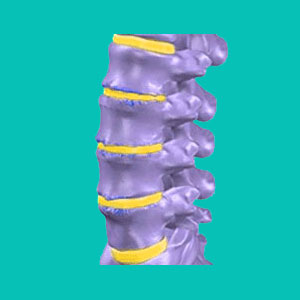
Various degenerative disc disease causes are inherently linked to the spinal aging processes. Disc degeneration is not a disease at all, but merely a completely normal, expected and universal part of getting older. While many factors can speed up disc degeneration, it is still rare that degenerative disc disease will cause any pain or become a significant health concern.
This article discusses the causative processes responsible for enacting degenerative changes to the intervertebral discs. Additionally, the prognosis for continuing disc degeneration will be explored in vivid detail.
Universal Degenerative Disc Disease Causes
Disc degeneration is characterized by a loss of moisture retaining ability in the nucleus pulposus. This makes the disc shrink in height, diameter and mass. As the disc desiccates, it is common for small annular tears to develop in the outer disc wall, especially in people who are very active or athletic.
Degeneration also contributes to the incidence of bulging and herniation of the intervertebral structures, since the strength of the annulus is compromised as it progressively dries out. Fortunately, small disc bulges are common and even ruptured discs affect many people without any painful symptoms.
The most typical area to experience disc degeneration is the lower lumbar spine, at levels L4/L5 and L5/S1. It is also very common to experience disc degeneration in the cervical spine, as well.
Accelerated Degenerative Disc Disease
Traumatic back injury can certainly promote accelerated disc degeneration.
Genetic patterns also make some people more prone to degeneration of the spine than others, or create typical degenerative changes at a far younger age.
Idiopathic reasons can also make some people susceptible to severe or early degenerative disc disease.
Other spinal abnormalities, such as advanced osteoarthritis, scoliosis, hyperlordosis or hyperkyphosis might increase the chances for more noticeable disc degeneration in some people.
Smoking is a known contributor to degeneration of the spinal structures.
Objectivity on Degenerative Disc Disease Causes
DDD is a very scary sounding condition, which is no accident in its nomenclature. The nocebo effect of the diagnosis is far more a logical source of continuing pain than the actual physical changes could ever be.
The vast majority of people diagnosed with DDD are merely experiencing the very same aging process endured by every other human on this planet, including the diagnosing physician. If you are diagnosed with DDD, especially lumbar disc disease or cervical disc disease, it should not be of any surprise or shock at all.
I was diagnosed with advanced degenerative changes at L4/L5 and L5/S1 at 16 years old. This is far younger than average and this diagnosis certainly set the tone for the next 2 decades of my life. My horrible back pain was originally blamed on these degenerated discs, until they herniated, then the pain was blamed on the herniations. I bought into this theory, since I had no reason to doubt my doctors and the diagnosis seemed logical to me. That is, until I did some research and discovered just how common DDD and herniated discs really are.
Once I began digging for more information, the less the diagnosis made sense. As I continued to learn about the normal processes which affect the spine, the diagnosis lost all credibility with me and by this time, I had cured my own pain, despite still having the physical degeneration and herniations in my back.
As a general rule, DDD is not a source of significant pain or neurological symptoms in most patients. If it is targeted as the causation, I advise patients to consider their diagnosis carefully, in order to avoid becoming a pawn to the symptomatic treatment industry. This is a fate I know well, having served 18 years of slavery, with no cure and no considerable relief, despite a world of treatments and a fortune spent in out-of-pocket financial expense.
Herniated Disc > Degenerative Disc Disease > Degenerative Disc Disease Causes





